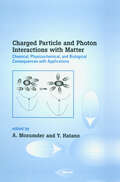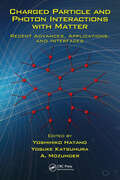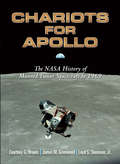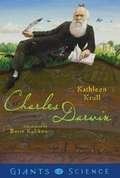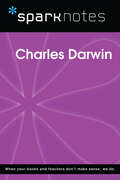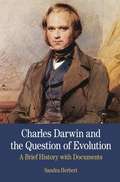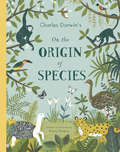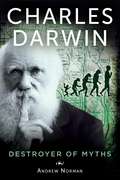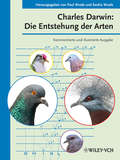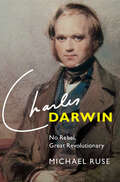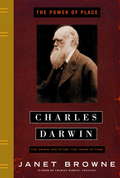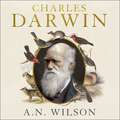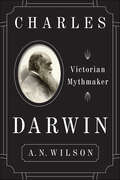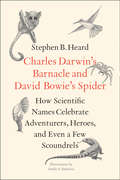- Table View
- List View
Charged Particle and Photon Interactions with Matter: Chemical, Physicochemical, and Biological Consequences with Applications
by A. Mozumder Y. HatanoCharged Particle and Photon Interactions with Matter offers in-depth perspectives on phenomena of ionization and excitation induced by charged particle and photon interactions with matter in vivo and in vitro. This reference probes concepts not only in radiation and photochemistry, but also in radiation physics, radiation biochemistry, and radiatio
Charged Particle and Photon Interactions with Matter: Recent Advances, Applications, and Interfaces
by A. Mozumder Yoshihiko Hatano Yosuke KatsumuraBuilding on Mozumder's and Hatano's Charged Particle and Photon Interactions with Matter: Chemical, Physicochemical, and Biological Consequences with Applications (CRC Press, 2004), Charged Particle and Photon Interactions with Matter: Recent Advances, Applications, and Interfaces expands upon the scientific contents of the previous volume by cover
Charged Up: The Story Of Electricity (Science Works)
by Jacqui BaileyDescribes how electrical energy is generated in power stations and how it travels through pylons, power cables, and wires into people's homes.
Chariots for Apollo: The NASA History of Manned Lunar Spacecraft to 1969 (Dover Books on Astronomy)
by Loyd S. Swenson Jr. Courtney G. Brooks James M. GrimwoodMillions around the world watched as the Apollo 11 astronauts "came in peace for all mankind" to take humanity's first steps on the moon. Their mission's triumph was equally attributable to a less visible crew of nearly 400,000 people in hundreds of different organizations. This official NASA history reveals the human story behind an epic achievement. Written by a trio of experts, it chronicles the engineering and management contributions to the success of Project Apollo, starting with the creation of NASA itself and tracing the design and development of the project's spacecraft and lunar vehicles as well as their operation in space.Refreshingly free of jargon and technical language, this accessible account focuses on the coordination of efforts behind the production of the Apollo service, command, and lunar modules. It covers three phases of spacecraft evolution: defining and designing the necessary vehicles; developing and qualifying them for the task; and operating them to achieve their objectives. The authors conducted numerous interviews with the project's participants and relied heavily on NASA's extensive archives. In addition to several appendixes, the text is supplemented with more than 100 photographs and illustrations that recapture the efforts of the dedicated team of thousands who reached for the moon.
Charles Darwin
by David C. KingEven as a young boy, Charles Darwin loved investigating the natural world. His father feared that Charles would never be a doctor or clergyman, and he was right. Darwin the passionate amateur became a full-fledged scientist, and over the next 20 years he gathered evidence for a theory of evolution that would change the world forever.
Charles Darwin
by Kathleen KrullAll his life, Charles Darwin hated controversy. Yet he takes his place among the Giants of Science for what remains an immensely controversial subject: the theory of evolution. Darwin began piecing together his explanation for how all living things change or adapt during his five-year voyage on HMS Beagle. But it took him twenty years to go public, for fear of the backlash his theory would cause. Once again, Kathleen Krull delivers a witty and astute picture of one of history's greatest scientists. .
Charles Darwin (SparkNotes Biography Guide)
by SparkNotesCharles Darwin (SparkNotes Biography Guide) Making the reading experience fun! SparkNotes Biography Guides examine the lives of historical luminaries, from Alexander the Great to Virginia Woolf. Each biography guide includes:An examination of the historical context in which the person lived A summary of the person&’s life and achievements A glossary of important terms, people, and events An in-depth look at the key epochs in the person&’s career Study questions and essay topics A review test Suggestions for further reading Whether you&’re a student of history or just a student cramming for a history exam, SparkNotes Biography guides are a reliable, thorough, and readable resource.
Charles Darwin - Leben und Werk: Würdigung eines großen Naturforschers und kritische Betrachtung seiner Lehre
by Wolfgang SchaumannVor 200 Jahren wurde einer der größten und bis heute umstrittenen Naturforscher geboren: Charles Darwin. Der Autor Wolfgang Schaumann schildert in seiner kritischen Würdigung von Darwins Lebenswerk historische und höchst aktuelle Auseinandersetzungen mit Darwins revolutionärer Theorie zur Evolution der Arten, die erstmals im Jahre 1859 von ihm veröffentlicht wurde. In einem Spannungsbogen, der sich über 150 Jahre hinzieht, lässt Schaumann den Leser miterleben, wie Darwins revolutionäre Theorie allen gegen sie vorgebrachten Argumenten getrotzt hat und sich gegen sämtliche Alternativtheorien immer wieder durchsetzen konnte. Spannend und lehrreich zugleich!
Charles Darwin and the Question of Evolution: A Brief History With Documents
by Sandra HerbertThe publication of Charles Darwin's On the Origin of Species in 1859 is widely regarded as a turning point in knowledge of the natural world. But Darwin's theory of natural selection was not developed in a vacuum; rather, it represents the culmination of an enormous shift in scientific and popular opinion on the subject of species mutability from the late eighteenth century onward. Through her insightful introduction and engaging collection of documents, Sandra Herbert examines this era of scientific thought and the startling discoveries that led Darwin and others to the conclusion that life has evolved. A wide range of documents from over a dozen authors -- including letters, illustrations, scientific tracts, and excerpts from Darwin's own notebooks and On the Origin of Species -- offer a fascinating glimpse into this crucial era of scientific thought. Thoughtful document headnotes, questions for consideration, a chronology, and a selected bibliography provide students with additional context and pedagogical support.
Charles Darwin and the Voyage of the Beagle
by Ruth AshbyIn 1831, young adventurer and nature enthusiast Charles Darwin set sail on a remarkable five-year voyage that changed the study of biology forever.Award-winning author Ruth Ashby shares the story of Darwin's famous journey aboard the British navy ship, the Beagle, which led to the development of his theories of evolution and natural selection.This lively account follows the naturalist's exciting trip around the world—through seasickness, a life-threatening illness, and even an earthquake—as he explores South America, the Cape Verde Islands, Tahiti, and the Galapagos Islands. During his travels, Darwin meets Indigenous peoples and carefully collects and catalogs plants, fossils, birds, mammals, and insects. Darwin's observations of the distribution and diversity of plant and animal life ultimately leads to the development of his theories on evolution.Readers will be inspired by Darwin's transformation from talented but mediocre schoolboy into a remarkable scientist as they read about the revolutionary voyage that forever changed the world of biology.
Charles Darwin's Around The World Adventure
by Jennifer ThermesIn 1831, Charles Darwin embarked on his first voyage. Though he was a scientist by profession, he was an explorer at heart. While journeying around South America for the first time aboard a ninety-foot-long ship named the Beagle, Charles collected insets, dug up bones, galloped with gauchos, encountered volcanoes and earthquakes, and even ate armadillo for breakfast! The discoveries he made during this adventure would later inspire ideas that changed how we see the world. <p><p> Complete with mesmerizing map work that charts Darwin's thrilling five-year voyage, as well as "Fun Facts" and more, Charles Darwin's Around-the-World Adventure captures the beauty and mystery of nature with wide-eyed wonder.
Charles Darwin's Incomplete Revolution: The Origin of Species and the Static Worldview (Evolutionary Biology – New Perspectives on Its Development #1)
by Richard G. DelisleThis book offers a thorough reanalysis of Charles Darwin's Origin of Species, which for many people represents the work that alone gave rise to evolutionism. Of course, scholars today know better than that. Yet, few resist the temptation of turning to the Origin in order to support it or reject it in light of their own work. Apparently, Darwin fills the mythical role of a founding figure that must either be invoked or repudiated. The book is an invitation to move beyond what is currently expected of Darwin's magnum opus. Once the rhetorical varnish of Darwin's discourses is removed, one discovers a work of remarkably indecisive conclusions. The book comprises two main theses: (1) The Origin of Species never remotely achieved the theoretical unity to which it is often credited. Rather, Darwin was overwhelmed by a host of phenomena that could not fit into his narrow conceptual framework. (2) In the Origin of Species, Darwin failed at completing the full conversion to evolutionism. Carrying many ill-designed intellectual tools of the 17th and 18th centuries, Darwin merely promoted a special brand of evolutionism, one that prevented him from taking the decisive steps toward an open and modern evolutionism. It makes an interesting read for biologists, historians and philosophers alike.
Charles Darwin's On the Origin of Species
by Sabina RadevaA picture book adaptation of Charles Darwin's groundbreaking On the Origin of Species, lushly illustrated and told in accessible and engaging easy-to-understand text for young readers.On the Origin of Species revolutionized our understanding of the natural world. Now young readers can discover Charles Darwin's groundbreaking theory of evolution for themselves in this stunning picture-book adaptation that uses stylish illustrations and simple text to introduce how species form, develop, and change over time.
Charles Darwin: Destroyer of Myths
by Andrew NormanCharles Darwin did not deliberately set out to be the "destroyer of mythical beliefs," some of which, in his early days as a young Christian, he had previously espoused. He was a modest man who liked to avoid controversy of any kind, yet paradoxically, he was to be the cause of the greatest controversy in the history of science and religion.When Darwin embarked on the HMS Beagle in late December 1831, bound for the southern hemisphere, he could not have imagined that the experience would lead him to formulate a theory which would totally revolutionize the way in which we viewed the natural world. He did not come to his conclusions about the origin and evolution of all life on Earth quickly, though, for just as the living organisms to which his theory applied had evolved over millions of years, so his thinking evolved as his own life progressed.How did this thoughtful, methodical scientist come to have such an impact on his time-and on ours? These questions and more are what Andrew Norman seeks to answer in this biography of the author of The Origin of Species.
Charles Darwin: Die Entstehung der Arten
by Paul Wrede Saskia WredeDas grundlegende Werk von Darwin On the Origin of Species liegt hier in der originalen Übersetzung durch Julius Victor Carus vor, erweitert durch zahlreiche Erläuterungen, aussagekräftige Abbildungen sowie wichtige historische Bezüge. Die Entstehung der Arten von Darwin ist für die heutige Leserschaft häufig schwierig zu verstehen. Eine hilfreiche Unterstützung erfolgt durch die farbliche Hervorhebung entscheidender Textstellen und viele fachliche Erklärungen. Darwins Analysen und Bewertungen aus den Gebieten der Botanik, Zoologie, Verhaltenslehre, Paläontologie und Entwicklungsbiologie werden in acht Beiträgen namhafter Fachwissenschaftler im Licht der gegenwärtigen Forschung beleuchtet und so wird erst die ungeheure Bedeutung und Weitsicht seines Werkes offensichtlich. Endlich liegen jetzt die Übersetzungen der beiden ebenso bahnbrechenden Aufsätze von Alfred Russel Wallace vor: der Sarawak- und Ternate-Essay. Wallace war neben Darwin der bedeutendste Evolutionsforscher seiner Zeit. Seine Arbeiten zur Evolutionsbiologie, die im Angelsächsischen hoch geschätzt sind, können als durchaus gleichrangig zu Darwins berühmtester Schrift angesehen werden. Ulrich Kutschera eröffnet das Buch mit einem Geleitwort und Reinhold Leinfelder schließt es mit einem Ausblick zur Bedeutung der Evolutionstheorie für die Zukunft des Menschen ab. Das Buch ist daher nicht nur eine unverzichtbare Lernhilfe für Schüler und Studenten, die sich mit der Evolutionsbiologie beschäftigen, sondern zusätzlich auch eine spannende weiterführende Lektüre für alle Leser mit Interesse an Wissenschaftsgeschichte.
Charles Darwin: Evolution and Natural Selection
by Charles Darwin Bert James Loewenberg"On the twenty-fourth of November, 1859, the London publishing house of John Murray issued a small green-backed volume. The volume was entitled On the Origin of Species by Means of Natural Selection, or the Preservation of Favoured Races in the Struggle for Life.1 Charles Robert Darwin, the author, was a scientist who had written on geological and zoological topics with monographic competence. He had also written an interesting travel account which had reached a much wider public. As a naturalist on H. M. S. Beagle, an admiralty vessel engaged in a routine survey, he had reported findings in many areas of natural history and had also recorded his experiences in foreign lands." -opening paragraph
Charles Darwin: No Rebel, Great Revolutionary
by Michael RuseCharles Darwin's theory of evolution was one of the most significant revolutions in the history of science. Widely debated after the publication of the Origin of Species in 1859, it continues to be controversial. In this volume, Michael Ruse offers the definitive history of the theory of evolution through natural selection. Tracing Darwin's intellectual journey and experiences that lead him to his novel insights, Ruse explores his scientific contributions as well as their relationship to philosophical issues and religious implications, as well as being both inspiration and challenge to novelists and poets. He also shows how the Darwin's ideas continue to have contemporary relevance, as they shed light on social issues and problems, such as race, sexual orientation and the connections between Darwin's thinking to that of Sigmund Freud, and the status of women, including the possibility and desirability of social change. Written in an engaging, non-technical style, Ruse's volume serves as an ideal introduction to the ideas of one of the key figures in the history of modern science.
Charles Darwin: The Concise Story of an Extraordinary Man
by Tim M. BerraTwo hundred years after Charles Darwin's birth (February 12, 1809), this thoroughly illustrated, yet concise biography reveals the great scientist as husband, father, and friend. Tim M. Berra, whose "Darwin: The Man" lectures are in high demand worldwide, tells the fascinating story of the person and the idea that changed everything. Berra discusses Darwin’s revolutionary scientific work, its impact on modern-day biological science, and the influence of Darwin’s evolutionary theory on Western thought. But Berra digs deeper to reveal Darwin the man by combining anecdotes with carefully selected illustrations and photographs. This small gem of a book includes 20 color plates and 60 black-and-white illustrations, along with an annotated list of Darwin’s publications and a chronology of his life.
Charles Darwin: The Concise Story of an Extraordinary Man
by Tim M. BerraA brief biography of English naturalist responsible for the advancement of the science of evolution.Two hundred years after Charles Darwin’s birth (February 12, 1809), this thoroughly illustrated, yet concise biography reveals the great scientist as husband, father, and friend.Tim M. Berra tells the fascinating story of the man and the idea that changed everything. Berra discusses Darwin’s revolutionary scientific work, its impact on modern-day biological science, and the influence of Darwin’s evolutionary theory on Western thought. But Berra digs deeper to reveal Darwin the man by combining anecdotes with carefully selected illustrations and photographs.This small gem of a book includes 20 color plates and 60 black-and-white illustrations, along with an annotated list of Darwin’s publications and a chronology of his life.“Berra meets the essential curiosities a reader new to Darwin will have about a scientist still controversial in some quarters: Berra describes Darwin’s wealthy family background; notes his search for a purpose in life, which led to his embarkation on the survey ship HMS Beagle; chronicles Darwin’s fabled voyage on that ship; steers Darwin into his happy marriage to an heiress to the Wedgwood pottery fortune; and recounts the éclat with which On the Origin of Species burst upon the world in 1859. . . . A finer asset of this volume is its abundance of portraits and illustrations, including a suite of photos taken by Berra of Darwin’s home.” —Booklist
Charles Darwin: The Power of Place
by Janet BrowneIn 1858 Charles Darwin was forty-nine years old, a gentleman scientist living quietly at Down House in the Kent countryside, respected by fellow biologists and well liked among his wide and distinguished circle of acquaintances. He was not yet a focus of debate; his "big book on species" still lay on his study desk in the form of a huge pile of manuscript. For more than twenty years he had been accumulating material for it, puzzling over questions it raised, trying--it seemed endlessly--to bring it to a satisfactory conclusion. Publication appeared to be as far away as ever, delayed by his inherent cautiousness and wish to be certain that his startling theory of evolution was correct.It is at this point that the concluding volume of Janet Browne's biography opens. The much-praised first volume, Voyaging, carried Darwin's story through his youth and scientific apprenticeship, the adventurous Beagle voyage, his marriage and the birth of his children, the genesis and development of his ideas. Now, beginning with the extraordinary events that finally forced the Origin of Species into print, we come to the years of fame and controversy.For Charles Darwin, the intellectual upheaval touched off by his book had deep personal as well as public consequences. Always an intensely private man, he suddenly found himself and his ideas being discussed--and often attacked--in circles far beyond those of his familiar scientific community. Demonized by some, defended by others (including such brilliant supporters as Thomas Henry Huxley and Joseph Hooker), he soon emerged as one of the leading thinkers of the Victorian era, a man whose theories played a major role in shaping the modern world. Yet, in spite of the enormous new pressures, he clung firmly, sometimes painfully, to the quiet things that had always meant the most to him--his family, his research, his network of correspondents, his peaceful life at Down House. In her account of this second half of Darwin's life, Janet Browne does dramatic justice to all aspects of the Darwinian revolution, from a fascinating examination of the Victorian publishing scene to a survey of the often furious debates between scientists and churchmen over evolutionary theory. At the same time, she presents a wonderfully sympathetic and authoritative picture of Darwin himself right through the heart of the Darwinian revolution, busily sending and receiving letters, pursuing research on subjects that fascinated him (climbing plants, earthworms, pigeons--and, of course, the nature of evolution), writing books, and contending with his mysterious, intractable ill health. Thanks to Browne's unparalleled command of the scientific and scholarly sources, we ultimately see Darwin more clearly than we ever have before, a man confirmed in greatness but endearingly human.Reviewing Voyaging, Geoffrey Moorhouse observed that "if Browne's second volume is as comprehensively lucid as her first, there will be no need for anyone to write another word on Darwin." The Power of Place triumphantly justifies that praise.From the Hardcover edition.
Charles Darwin: Victorian Mythmaker
by A N Wilson'Hugely enjoyable' - Spectator'A lucid, elegantly written and thought-provoking social and intellectual history' - Evening Standard'As a historian trying to put Darwin in the context of his time, there is surely no better biographer than Wilson' - The Times'A work of scholarship that is hard to put down' - Deborah CadburyCharles Darwin: the man who discovered evolution? The man who killed off God? Or a flawed man of his age, part genius, part ruthless careerist who would not acknowledge his debts to other thinkers?In this bold new life - the first single volume biography in twenty-five years - A. N. Wilson, the acclaimed author of The Victorians and God's Funeral, goes in search of the celebrated but contradictory figure Charles Darwin.Darwin was described by his friend and champion, Thomas Huxley, as a 'symbol'. But what did he symbolize? In Wilson's portrait, both sympathetic and critical, Darwin was two men. On the one hand, he was a naturalist of genius, a patient and precise collector and curator who greatly expanded the possibilities of taxonomy and geology. On the other hand, Darwin, a seemingly diffident man who appeared gentle and even lazy, hid a burning ambition to be a universal genius. He longed to have a theory which explained everything.But was Darwin's 1859 master work, On the Origin of Species, really what it seemed, a work about natural history? Or was it in fact a consolation myth for the Victorian middle classes, reassuring them that the selfishness and indifference to the poor were part of nature's grand plan? Charles Darwin: Victorian Mythmaker is a radical reappraisal of one of the great Victorians, a book which isn't afraid to challenge the Darwinian orthodoxy while bringing us closer to the man, his revolutionary idea and the wider Victorian age.
Charles Darwin: Victorian Mythmaker
by A N WilsonCharles Darwin: the man who discovered evolution? The man who killed off God? Or a flawed man of his age, part genius, part ruthless careerist who would not acknowledge his debts to other thinkers?In this bold new life - the first single volume biography in twenty-five years - A. N. Wilson, the acclaimed author of The Victorians and God's Funeral, goes in search of the celebrated but contradictory figure Charles Darwin.Darwin was described by his friend and champion, Thomas Huxley, as a 'symbol'. But what did he symbolize? In Wilson's portrait, both sympathetic and critical, Darwin was two men. On the one hand, he was a naturalist of genius, a patient and precise collector and curator who greatly expanded the possibilities of taxonomy and geology. On the other hand, Darwin, a seemingly diffident man who appeared gentle and even lazy, hid a burning ambition to be a universal genius. He longed to have a theory which explained everything.But was Darwin's 1859 master work, On the Origin of Species, really what it seemed, a work about natural history? Or was it in fact a consolation myth for the Victorian middle classes, reassuring them that the selfishness and indifference to the poor were part of Nature's grand plan? Charles Darwin: Victorian Mythmaker is a radical reappraisal of one of the great Victorians, a book which isn't afraid to challenge the Darwinian orthodoxy while bringing us closer to the man, his revolutionary idea and the wider Victorian age.(P)2017 John Murray Press Limited
Charles Darwin: Victorian Mythmaker
by A.N. WilsonA radical reappraisal of Charles Darwin from the bestselling author of Victoria: A Life.With the publication of On the Origin of Species, Charles Darwin—hailed as the man who "discovered evolution"—was propelled into the pantheon of great scientific thinkers, alongside Galileo, Copernicus, and Newton. Eminent writer A. N. Wilson challenges this long-held assumption. Contextualizing Darwin and his ideas, he offers a groundbreaking critical look at this revered figure in modern science.In this beautifully written, deeply erudite portrait, Wilson argues that Darwin was not an original scientific thinker, but a ruthless and determined self-promoter who did not credit the many great sages whose ideas he advanced in his book. Furthermore, Wilson contends that religion and Darwinism have much more in common than it would seem, for the acceptance of Darwin's theory involves a pretty significant leap of faith.Armed with an extraordinary breadth of knowledge, Wilson explores how Darwin and his theory were very much a product of their place and time. The "Survival of the Fittest" was really the Survival of Middle Class families like the Darwins—members of a relatively new economic strata who benefited from the rising Industrial Revolution at the expense of the working classes. Following Darwin’s theory, the wretched state of the poor was an outcome of nature, not the greed and neglect of the moneyed classes. In a paradigm-shifting conclusion, Wilson suggests that it remains to be seen, as this class dies out, whether the Darwinian idea will survive, or whether it, like other Victorian fads, will become a footnote in our intellectual history.Brilliant, daring, and ambitious, Charles Darwin explores this legendary man as never before, and challenges us to reconsider our understanding of both Darwin and modern science itself.
Charles Darwin’s Barnacle and David Bowie’s Spider: How Scientific Names Celebrate Adventurers, Heroes, and Even a Few Scoundrels
by Stephen B. HeardAn engaging history of the surprising, poignant, and occasionally scandalous stories behind scientific names and their cultural significance Ever since Carl Linnaeus&’s binomial system of scientific names was adopted in the eighteenth century, scientists have been eponymously naming organisms in ways that both honor and vilify their namesakes. This charming, informative, and accessible history examines the fascinating stories behind taxonomic nomenclature, from Linnaeus himself naming a small and unpleasant weed after a rival botanist to the recent influx of scientific names based on pop-culture icons—including David Bowie&’s spider, Frank Zappa&’s jellyfish, and Beyoncé&’s fly. Exploring the naming process as an opportunity for scientists to express themselves in creative ways, Stephen B. Heard&’s fresh approach shows how scientific names function as a window into both the passions and foibles of the scientific community and as a more general indicator of the ways in which humans relate to, and impose order on, the natural world.
Charles Fort: Prophet of the Unexplained
by Damon KnightFrom the book: Charles Fort was convinced that there is a great deal going on in our universe which man has not as yet been able to explain. He was, of course, right. Fort amassed reports of events allegedly observed by humans around the world. Fort's books are full of reports of strange phenomena-such as those similar in every way to today's reports of flying saucers but centuries before they were called flying saucers. Boole gave scientists a powerful tool for attacking problems when the obvious approaches refused to yield informative results. Boole employed reductio ad absurdum. He exhausted all the impossibles and thereby isolated a "very probable" answer. Charles Fort, failing to gain the publishers'-and thereby society's-consideration of his positive theories, left world society with a Boolean-like confrontation of illogical events. Charles Fort as a man of true vision purposefully inverted the equations. By getting the publishers to publish the absurd, he proved his point that the publishers published only the absurd.
